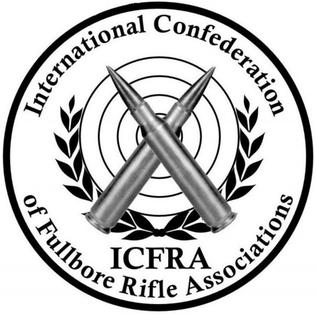
Shooting sports is a group of competitive and recreational sporting activities involving proficiency tests of accuracy, precision and speed in shooting — the art of using ranged weapons, mainly small arms and bows/crossbows.

Shooting sports have been included at every Summer Olympic Games since the birth of the modern Olympic movement at the 1896 Summer Olympics except at the 1904 and 1928 games.

United States Marine Corps Scout Sniper was a secondary MOS designator of U.S. Marine Corps infantrymen and reconnaissance Marines that have graduated from a U.S. Marine Corps Scout Sniper School. Scout Snipers must earn the rank of Lance Corporal, be selected by their battalion to join the scout-sniper platoon, and complete an approved scout-sniper course in order to receive this designation. As of December 2023, Marine scout snipers have been reorganized as MOS 0322 Reconnaissance Sniper Marines, as part of a 26-Marine Scout Platoon.

Venezuela competed at the 1956 Summer Olympics held in Melbourne, Australia, and in the equestrian events held in Stockholm, Sweden. Twenty-two competitors, all men, were selected by the Venezuelan Olympic Committee to take part in sixteen events across five sports. The delegation featured no female competitors, for the second time, and won no medals. While most of the Venezuelan athletes did not advance past the qualifying rounds of their sports, there were some good placings in the shooting, with Germán Briceño and Carlos Monteverde finishing in the top 10 of their events.

The 300 m rifle three positions event was one of five free rifle events of the competitions in the Shooting at the 1900 Summer Olympics events in Paris. They were held from August 3 to August 5, 1900. 30 shooters from 6 nations competed, with five shooters per team. Medals were given for individual high scores in each of the three positions, overall individual high scores, and the scores of the five shooters were summed to give a team score. The three positions event was won by Emil Kellenberger of Switzerland. Anders Peter Nielsen of Denmark took silver, while Ole Østmo of Norway and Paul Van Asbroeck of Belgium tied for bronze.

The men's 200 metre military rifle event was one of five sport shooting events on the Shooting at the 1896 Summer Olympics programme. It was held at a distance of 200 metres, on 8 April and 9 April, with each shooter firing half of his shots on the first day and half the second. Shooters fired four strings of ten shots each, for a total of 40 shots. 42 shooters, representing each of the seven nations that had shooters in Athens, competed.
The men's free rifle at 1000 yards was one of 15 events on the Shooting at the 1908 Summer Olympics programme. Each shooter fired 20 shots with a rifle at the target 1,000 yards away. A bulls-eye was worth 5 points, so the maximum possible score was 100. Each nation could enter up to 12 shooters.

The men's 300 m rifle three positions was one of 15 events on the shooting at the 1908 Summer Olympics programme. The competition was held on Saturday, 11 July 1908. Each nation could enter up to 12 shooters. Fifty-one sport shooters from ten nations competed. The event was won by Albert Helgerud of Norway, the nation's first victory in the event. Norway also won bronze, with Ole Sæther finishing third. Between the two Norwegians was Harry Simon, taking silver in the United States' debut.

The men's team free rifle at 300 metres was one of 15 events on the shooting at the 1908 Summer Olympics programme. The competition was held on Thursday, 9 July 1908 and was extended after sunset to Friday, 10 July 1908 — it was the first shooting event of the Games. Fifty-four sport shooters from nine nations competed. The event was won by the team from Norway, improving on their second-place finish in 1900. Sweden made its debut in the event, taking silver. France repeated as bronze medalists.
The men's stationary target small-bore rifle, also referred to as the miniature rifle competition, was one of 15 events on the Shooting at the 1908 Summer Olympics programme. Regulation of the equipment used in the event was done through proscribing ammunition weighing more than 140 grains, with a velocity of more than 1,450 feet per second, or having a hard metal base. Magnifying and telescopic sights were prohibited. Each shooter fired 80 shots, half at 50 yards and half at 100 yards. Maximum score for a shot was 5 points, giving a maximum total possible of 400 points.
The men's disappearing target small-bore rifle was one of 15 events on the Shooting at the 1908 Summer Olympics programme. Regulation of the equipment used in the event was done through allowing the use of .22 or .297/.230 caliber ammunition. Magnifying and telescopic sights were prohibited. The target used was a three-quarter length silhouette, 4 inches high and 1.5 wide. It would appear at a distance of 25 yards for three seconds and then disappear for five until it had been seen a total of 15 times. A hit on the upper two-thirds of the figure counted for 3 points, while any other hit counted for 1. The maximum score was thus 45 points. Each nation could enter up to 12 shooters.
The men's moving target small-bore rifle was one of 15 events on the Shooting at the 1908 Summer Olympics programme. Regulation of the equipment used in the event was done through allowing the use of .22 LR or .297/.230 caliber ammunition. Magnifying and telescopic sights were prohibited. The target used was a three-quarter length silhouette, 10 cm (4 in) high and 3.8 cm (1.5 in) wide. It would appear at a distance of 23 m (25 yd), moving across a 3 m (10 ft) range over the course of 4 seconds. A hit on the upper two-thirds of the figure counted for 3 points, while any other hit counted for 1 point. 15 shots were fired per competitor. The maximum score was thus 45 points. Each nation could enter up to 12 shooters.
The men's team small-bore rifle was one of 15 events on the Shooting at the 1908 Summer Olympics programme. Teams consisted of four shooters. Regulation of the equipment used in the event was done through proscribing ammunition weighing more than 140 grains, with a velocity of more than 1,450 feet per second, or having a hard metal base. Magnifying and telescopic sights were prohibited. Each shooter fired 40 shots, half at 50 yards and half at 100 yards. Maximum score for a shot was 5 points, giving a maximum total possible of 200 points per shooter or 800 per team.

The men's individual revolver and pistol competition was one of 15 shooting sports events on the shooting at the 1908 Summer Olympics programme. The competition was held on Friday, 10 July 1908. Each nation could enter up to 12 shooters. Forty-three sport shooters from seven nations competed. Nations were limited to 12 shooters each. The event was won by Paul Van Asbroeck of Belgium, with his countryman Réginald Storms taking silver. They were the first medals for Belgian shooters in the free pistol. American James Gorman finished with the bronze medal after an unsuccessful protest, claiming he had put one bullet through a previous hole.

The men's team revolver and pistol competition was one of 15 shooting sports events on the Shooting at the 1908 Summer Olympics programme. It was held on 11 July. There were 28 competitors from 7 nations, with each nation sending a team of four. The event was won by the United States in the nation's debut in the event. All three teams on the podium were new; Great Britain (bronze) was also making its debut, while Belgium (silver) had finished fourth in 1900.
The men's team single-shot 100 meter running deer competition was one of 15 shooting sports events on the Shooting at the 1908 Summer Olympics programme. Teams consisted of four shooters. A deer-shaped target made 10 runs of 75 feet, with the shooter firing one shot during each run. The runs lasted about 4 seconds each and took place 110 yards distant from the shooter. There were three concentric circles on the target, with the smallest counting for 4 points, the middle for 3, and the outermost for 2. A hit outside the circles but still on the target counted for 1 point. The maximum possible score was thus 40 points per shooter, or 160 for the team.

The men's individual competition with revolver and pistol was a shooting sports event held as part of the Shooting at the 1920 Summer Olympics programme. It was the fifth appearance of such an event at different distances. The competition was held on 2 August 1920. 31 shooters from 8 nations competed. The event was won by Karl Frederick of the United States, the nation's second consecutive and third overall victory in the event. Defending champion Alfred Lane took bronze, the first man to win multiple medals in the event. Brazil's Afrânio da Costa finished between the two Americans, taking silver.

The men's ISSF 50 meter pistol was one of the thirteen shooting events at the 1988 Summer Olympics. It was the second Olympic free pistol competition to feature final shooting, after an abortive attempt in 1960. There were 43 competitors from 31 nations. Nations had been limited to two shooters each since the 1952 Games. The event was won by Sorin Babii of Romania, the nation's first victory in the event and first medal in free pistol since 1972. Ragnar Skanåker of Sweden repeated as silver medalist, the second man to earn three medals in the free pistol; four years later, he would become the first to win four medals. Soviet Igor Basinski took bronze.

High Power Rifle, also called XTC from "Across the Course", is a shooting sport using fullbore target rifles which is arranged in the United States by the National Rifle Association of America (NRA). The sport is divided into classes by equipment, and popular types of matches include Service Rifle, Open, Axis and Allies and metallic silhouette. The term High Power Rifle sometimes also includes the international shooting disciplines of Palma and F-Class by the International Confederation of Fullbore Rifle Associations (ICFRA) which are represented by the NRA in the United States.

The International Confederation of Fullbore Rifle Associations (ICFRA) is the international association for the fullbore rifle shooting sports of target rifle ('TR') (called 'Palma' rifle in the US) and F-Class, which are long range competitions shot at distances between 300 and 900 meters or 300 to 1,000 yards depending on the range. F-Class shooters often shoot concurrently with the world's long-range TR shooters and use the same targets, except that the F-Class target has an extra ring half the diameter of the smallest in use for TR. ICFRA manages the programme of World Championships and other major matches for Fullbore Rifle and seeks to standardize the competition rules for TR and F-Class around the world.











